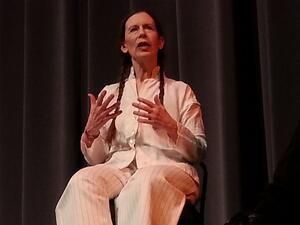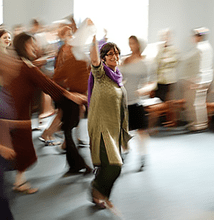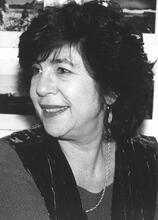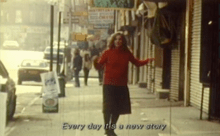Meredith Monk
Meredith Monk at the Krannert Cernter for the Performing Arts in Urbana, Illinois, 2014.
Courtesy of Marc-Anthony Macon.
Meredith Monk was born in 1942, in Peru, where her mother, a professional singer, was on tour. In 1950, her family moved to Connecticut, and Monk continued her early training in music at Sarah Lawrence College. Graduating in 1964, she soon began to choreograph to her own music. In 1968, she formed the House Foundation for the Arts and created a repertory of theater works for which she devised the dramatic structure, composed the music, choreographed the movement, and acted, danced, and sang with her group. Monk’s diverse works range from media experimentation and live performance, to racial, historical studies and film. Her work frequently incorporates aspects of Jewish history and heritage and has received many awards and honors.
Overview
An innovator in mixed-media forms, Meredith Monk uses music, dance, drama, and film in theater pieces that may move between ancient times and modern, between exotic fantasy and everyday reality. In her pieces, the plague of the Middle Ages is seen as the precursor of AIDS, while St. Joan dies as motorcycles speed by her. Acting as composer, choreographer, librettist, and performer, Monk has created a diversity of works, ranging from the media experimentation of Sixteen Millimeter Earrings (1966), with its segments of film and taped singing along with live performance, to racial, historical studies, as in the site-specific Ellis Island (1983), which dramatically traces the brave immigrants’ arrival in the New World at the turn of the century.
Early Life and Training
Monk was born on November 20, 1942, to Audrey Lois (Zellman) Monk and Theodore Glenn Monk in Lima, Peru, where her mother, a professional singer, was on tour. She has described herself as “Inca Jewish.” She has one sister, Tracy. In 1950, the family moved to Connecticut. Monk continued her early training in music at Sarah Lawrence College, where she also studied modern dance with Bessie Schönberg. Graduating in 1964, she soon began to choreograph to her own music, always starting with an idea, then letting the media and the structure find themselves.
In 1968, Monk formed the House Foundation for the Arts to develop a group of artists committed to an interdisciplinary approach to performance. Working with some twenty performers, who had to be skilled—as she is—in acting, dancing, and singing, Monk proceeded to create a repertory of theater works: devising the dramatic structure, composing the music, choreographing the movement, and acting, dancing, and singing with her group.
Early Performance Works
In New York City in 1969, the first section of Juice used eighty-five performers on the spiral ramp of the Guggenheim Museum. The second section put a smaller number on the stage of the Minor Latham Playhouse, and the third took place in Monk’s home loft, where television screens displayed various scenes, but no live performers appeared. In 1971, Vessel: An Opera Epic, featuring the character of Joan of Arc, took place on a single evening, beginning in Monk’s loft, continuing in the Performing Garage, and concluding in a parking lot. The Education of the Girlchild (1972) was an extended solo in a single space, beginning with the dancer as a withered old woman and ending with her as a radiant young girl.
More specific characters appeared in Quarry (1976), where a child lying in bed cried, “I don’t feel well, I don’t feel well,” and in lighted corners around her, visions appeared of her present life and her family history: a maid peeling an orange and reading a magazine; an Old Testament couple fleeing as a dictator appears; victims dropping their jewelry and money as Nazis lead them away; a film showing a quarry with bodies emerging and disappearing, then floating on a pond.
Films and Later Performance Art
In the film Book of Days (1989), scenes of an ancient world in black and white intermingle with scenes of the modern world in color. In a medieval ghetto, a child envisions a future of airplanes and television; to her grandfather, they are visions of Noah’s Ark. The ancient wisdom of the Jewish heritage is transmitted from generation to generation. Both plague in the medieval world and AIDS in the modern are shown to threaten destruction. In the film, ancient houses crumble as automobile horns are heard in the distance.
Monk has continued to make increasingly complex site-specific works. In 1994, American Archeology No. 1: Roosevelt Island featured a cast of sixty on an island in Manhattan’s East River. The first act shows happy dancers in a spacious park. The second act, performed at night on the ruins of a smallpox hospital, shows the helpless gestures of convicts and weary patients. But in the end, a peacefully lighted hilltop serves as a sign of hope.
Exhibitions, Awards, and Honors
Monk titled the 1996 exhibition of her work at the New York Public Library for the Performing Arts Archeology of an Artist. For the brochure she wrote: “In a sense I think of myself as a vocal archeologist, trying to dig down to the most fundamental human utterances, the most elemental forms.... In the larger works, I combine forms weaving together music, movement, film object, light and ambiance. This multi-dimensional approach hopefully creates a poetry of sound, image and movement that increases the luminosity and radiance of the experience.”
Monk continues to develop every varying forms for her musical creations. In 1999, she performed a “Vocal Offering” for the Dalai Lama as part of the World Festival of Sacred Music in Los Angeles. Her latest music theater work, “mercy,” a collaboration with visual artist Ann Hamilton, was first performed at the 2001 American Dance Festival, and her first orchestral piece, “Possible Sky,” premiered in April 2003.
For her dance-operas, theater pieces, musical compositions, and films, Monk has received a number of awards and honors, including two Guggenheim Fellowships, the Brandeis Creative Arts Award, a MacArthur Foundation Fellowship, three Obie Awards, six ASCAP Awards for Musical Composition, the Dance Magazine Award, the Samuel H. Scripps American Dance Festival Award and the Doris Duke Award for New Work at the 1999 American Dance Festival. Her music was honored by the three concert retrospective “Voice Travel” at the 2000 Lincoln Center Festival, and her sound installation “Eclipse Variations” was included in the Whitney Museum of American Art 2002 Biennial. In a 1983 brochure, Monk defined her goal as creating “an art that breaks down boundaries between disciplines, an art which in turn becomes a metaphor for opening up thought, perception, experience.” Her goal has remained constant: “An art which reaches towards emotion that we have no words for, that we barely remember—an art that affirms the world of feeling in time and society where feelings are being systematically eliminated.”
Selected Works by Meredith Monk
American Archeology No. 1: Roosevelt Island (1994).
Archeology of an Artist (1996).
Book of Days, film (1989).
The Education of the Girlchild (1972).
Ellis Island (1983).
Four Services in Celebration of the Universal Human Quest for Spirituality (1996).
Juice (1969).
Quarry (1976).
Sixteen Millimeter Earrings (1966).
Vessel: An Opera Epic (1971).
Anderson, Jack. “Entering a World Only Meredith Monk Can Map.” NYTimes, June 16, 1996; Current Biography; Dance collection. New York Public Library for the Performing Arts, Lincoln Center; Encyclopedia Americana.
Jowitt, Deborah. “Ice Demons, Clicks, and Whispers.” NYTimes Magazine, June 30, 1991; Who’s Who in America.
Zurbrugg, Nicholas. “Meredith Monk: Music That Dances, Dances That Sing.” Dance Theatre Journal (Winter 1992–1993); Videotape collections. New York Public Library, and the House Foundation for the Arts, NYC.







